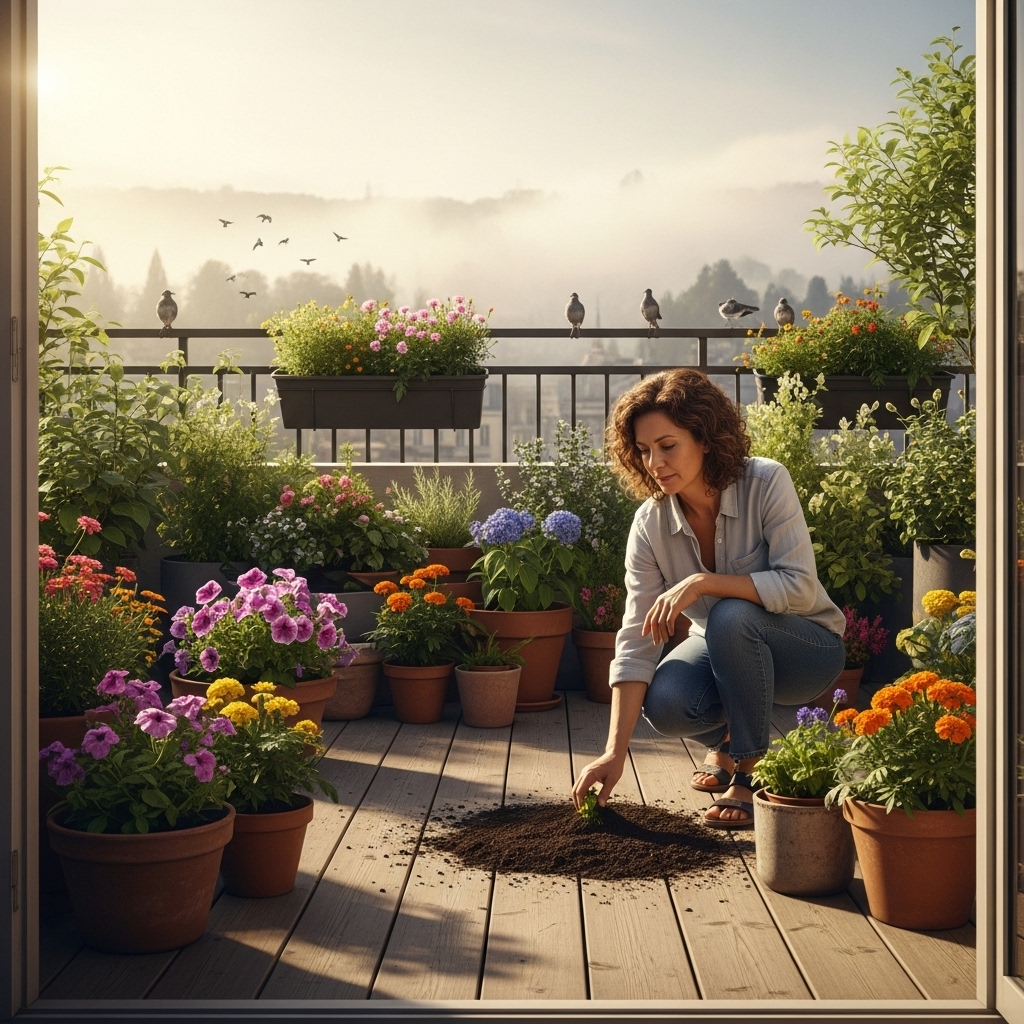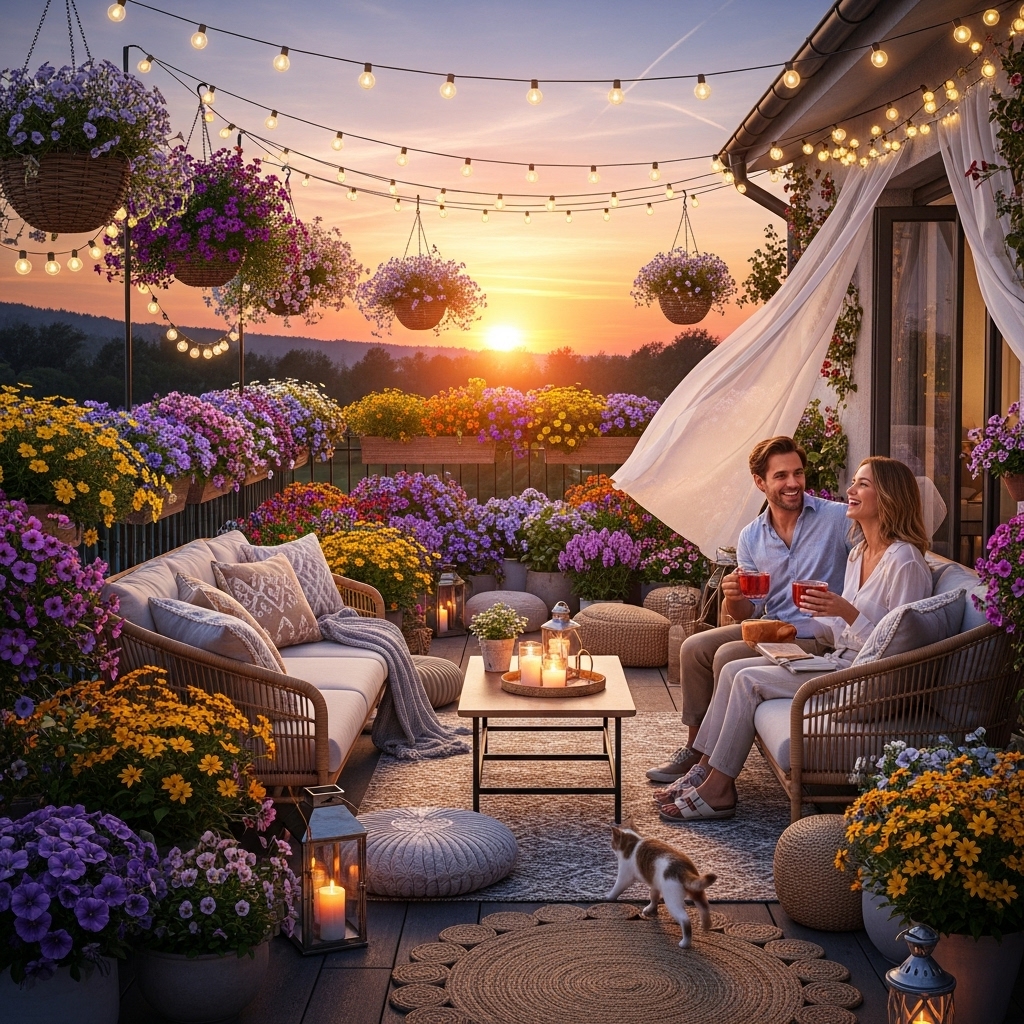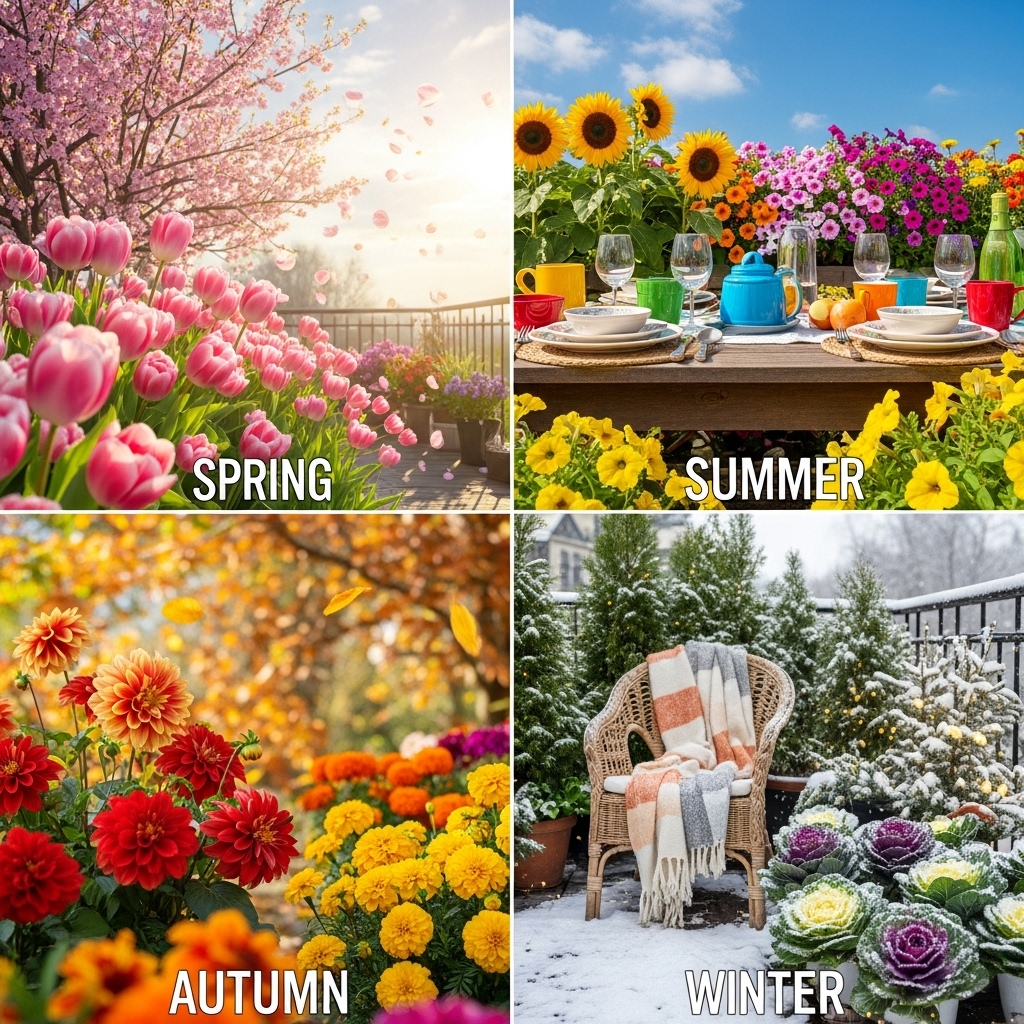Transforming my terrace into a blooming oasis has been one of the most rewarding experiences of my life. With just a few flowers and a bit of creativity, I learned how to turn a bare space into a vibrant retreat.
Understanding Your Space: Assessing the Terrace

When I first set out to transform my terrace, I quickly realized that the journey begins with understanding the space I had. I stepped outside, took a deep breath, and observed every inch of my bare terrace. If you’re looking to create your own sun-drenched haven, I recommend starting with an assessment of your area. Take note of the sunlight patterns, the size of the space, and the existing features like railings and flooring.
Sunlight: The Key Ingredient
One of the primary factors to consider is how much sunlight your terrace receives throughout the day. I remember being puzzled by how a few feet could make such a difference. My terrace was divided by a wall, creating two distinct zones: one that basked in the sun and another that rarely saw it. If you’re unsure about the sunlight your terrace gets, I suggest observing it at different times of the day. Write down how long each area is in the sun and in the shade. This will help you select the right flowers, as different plants have varying light requirements.
Space and Size: Planning Your Layout
Next, I took measurements of my terrace to understand what I was working with. This step was crucial because it helped me visualize what I could fit into the space. I sketched a rough layout, marking areas for planters, pots, and any seating arrangements I wanted to include. The key was to balance aesthetics with functionality. I wanted my terrace to be beautiful, but it also needed to serve as a space where I could relax and unwind.
As I thought about the layout, I realized I could use vertical space creatively. Instead of solely relying on horizontal planters, I decided to incorporate wall-mounted pots and hanging baskets, which would add dimension without overcrowding the floor area. This strategy proved to be a game changer, allowing me to maximize my plants without sacrificing comfort.
Choosing the Right Flowers
With a better understanding of my terrace’s space, it was time to choose the flowers. This was the part I found most exciting. I headed to my local nursery, overwhelmed by the dazzling array of colors, shapes, and sizes. I learned that selecting flowers is not just about aesthetics; it’s also about practicality. I wanted to choose a mix of annuals and perennials, ensuring that I had blooms throughout the seasons.
Annuals, like petunias and geraniums, offered vibrant colors and immediate satisfaction, as they bloom all summer long. However, I didn’t want to neglect perennials such as echinacea and daylilies, which would return year after year, providing a sense of continuity and ease. I found that creating a balance between these two types allowed me to enjoy both immediate beauty and long-term investment.
Color Schemes and Themes
As I stood in front of the flower display, I considered how I could create a cohesive color scheme. I wanted the colors to harmonize, creating a serene yet lively atmosphere. I gravitated towards a palette of purples, pinks, and whites, which felt soothing and inviting. It was essential for me to think about how these colors would look not just individually but together. I used a simple rule: choose three main colors and then two accent colors. This method helped me maintain a focused theme without overwhelming the senses.
Incorporating various shades of the same color also added depth to my design. For instance, mixing deep purple petunias with lighter lavender varieties created a beautiful gradient effect. I also explored the idea of seasonal flowers that could complement my main color palette and provide interest throughout the year.
Care and Maintenance: The Heart of Blooming
Once I settled on my flower choices, I knew that the journey was far from over. The real work would come in the form of care and maintenance. I quickly learned that understanding how to care for my plants was just as important as picking the right ones. Each flower had its unique needs, from watering and sunlight to soil and fertilizers.
I started by researching the specific requirements for each flower variety I chose. I created a simple chart that helped me visualize their needs, including watering frequency, sunlight requirements, and ideal soil type. This organization made it easier to keep track of what needed attention and when. I also found that keeping a regular watering schedule helped me avoid the dreaded wilting phase that I had encountered when I first began my gardening journey.
Creating a Lush Environment
To enhance the blooming effect and create a lush atmosphere, I decided to add layers of greenery with foliage plants. Incorporating plants like ferns and trailing vines not only added texture but also complemented the flowers beautifully. I placed some taller plants in the back and hung cascading varieties from above, creating a sense of depth that made my terrace feel more inviting.
Finally, I learned the importance of regularly deadheading my flowers and keeping an eye out for pests. Consistent care ensured that my blooms remained vibrant and healthy. I discovered that my terrace wasn’t just a space for flowers; it became a sanctuary where I could unwind, reflect, and connect with nature.
Adding Functional Elements: Furniture and Accessories

As I continued to refine my blooming oasis, I realized that it wasn’t just about the plants. The right furniture and accessories could transform my terrace into a true retreat. I wanted a space where I could sit with a cup of coffee, read a book, or even entertain friends. This meant I needed to carefully choose pieces that complemented the garden while ensuring comfort and functionality.
Choosing the Right Furniture
My first priority was selecting furniture that would withstand the elements while providing a cozy atmosphere. I opted for weather-resistant materials like teak and powder-coated metal, which would hold up against the rain and sun. I also made sure to choose pieces that were not too bulky, as I wanted to keep the open feel of my terrace intact.
After browsing through various options, I settled on a compact bistro table and a couple of folding chairs. This setup allowed me to create a dining space without overwhelming the area. I also added a small side table where I could place my plants or refreshments. The versatility of folding chairs meant I could easily tuck them away when I needed more space for my plants or simply wanted to enjoy the view.
Creating Comfort with Textiles
To enhance the comfort of my terrace, I knew I needed to incorporate some textiles. I selected outdoor cushions in colors that matched my chosen flower palette, bringing everything together beautifully. Not only did they add a pop of color, but they also made sitting outside much more enjoyable. I also considered adding a soft outdoor rug to define the seating area, creating a cozy nook amidst the greenery.
I learned the importance of materials when it came to outdoor textiles. I made sure to choose fabrics that were UV-resistant and water-repellent. This way, they would stay vibrant and last longer even when exposed to the elements. I quickly discovered that the right textiles could make all the difference, turning a simple seating area into a warm and inviting space.
Accessorizing with Personal Touches
As I set up my furniture, I wanted to add a few personal touches that reflected my personality. I began by incorporating decorative planters in unique shapes and sizes. Some of these pots were handmade ceramics that I had collected during my travels, while others were simple terracotta painted in bright colors. Each planter added a unique character to my terrace, making it feel like an extension of my home.
I also decided to add some outdoor lighting to create a magical ambiance for evening relaxation. String lights draped across the railing and solar-powered lanterns placed strategically around the terrace brought my space to life at night. The soft glow transformed my terrace into a cozy retreat where I could unwind under the stars.
Incorporating Nature with Water Elements
To enhance the calming atmosphere, I thought about adding a water feature. I chose a small tabletop fountain, which not only provided the soothing sound of trickling water but also attracted birds and butterflies. This addition brought another layer of life to my terrace, making it feel more like a natural sanctuary. Watching the birds splash around in the fountain became one of my favorite pastimes.
Additionally, I placed a few small bowls of water around the terrace to provide drinking spots for birds and insects. This simple act connected me further with nature and created a vibrant ecosystem right outside my window.
Seasonal Adjustments: Adapting Your Terrace for Year-Round Enjoyment

As I enjoyed my blooming oasis, I came to realize that the changing seasons meant I would need to adapt my terrace accordingly. Each season brought its own set of challenges and opportunities, and I wanted to make the most of them. I began to research which plants thrived in each season and how I could adjust my layout to accommodate these changes.
Spring and Summer: The Peak Blooming Season
During spring and summer, I reveled in the vibrant blooms of my annual flowers. This was when my terrace truly came alive, bursting with color and fragrance. I made sure to keep up with regular maintenance, including deadheading and watering, to keep everything looking its best. I also experimented with different combinations of flowers, changing them up for variety and freshness.
Autumn: Transitioning the Space
As summer faded, I began transitioning my space for autumn. I swapped out some of my summer annuals for hardy fall flowers like chrysanthemums and ornamental cabbages. The rich oranges, yellows, and deep reds added a warm and inviting touch to my terrace. I also added cozy throws to my seating area, encouraging me to still enjoy the outdoors as temperatures dropped.
Winter: Preparing for the Cold
In winter, my priority shifted to protecting my plants from the cold. I learned how to properly mulch and cover my perennials to ensure they survived the frost. I also took the opportunity to bring some plants indoors, enjoying their beauty throughout the winter months. I discovered that even in the colder seasons, there were ways to keep my terrace inviting by strategically placing evergreen plants that added life and color against the stark winter backdrop.
As I navigated through each season, I found that adapting my terrace not only kept it looking fresh but also deepened my connection to the natural world around me. Each season offered unique beauty and challenges, making my journey in gardening all the more rewarding.
Final Thoughts
Transforming my terrace into a blooming oasis has been a journey filled with creativity, patience, and a deep appreciation for nature. It has taught me valuable lessons about gardening and home aesthetics, as well as the joy that comes from nurturing a space. Whether it’s the vibrant colors of spring or the tranquility of a winter retreat, my terrace has become a personal sanctuary, a testament to the beauty that can be created with a little effort and love.
